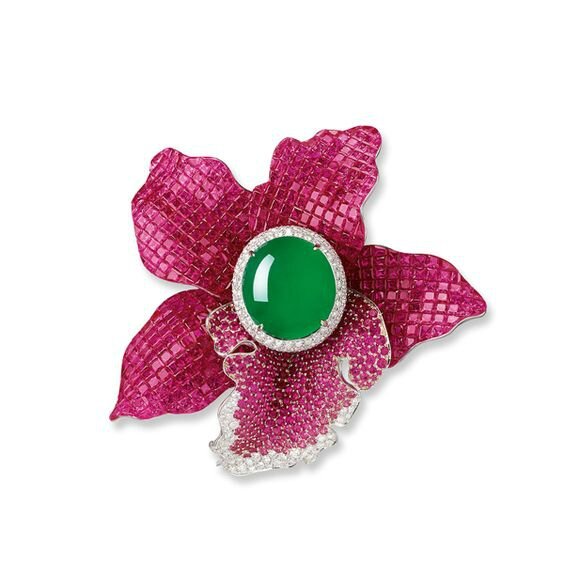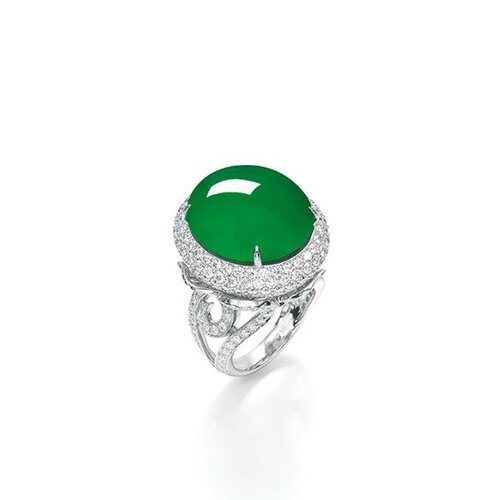Impressive jadeite, ruby, pink sapphire and diamond 'Orchid' brooch-ring
Lot 213. Impressive jadeite, ruby, pink sapphireand diamond 'Orchid' brooch-ring. Estimate HK$3,500,000 - 4,500,000 (US$450,000 - 577,000). Courtesy Tiancheng International
Modelled as an orchid, the brooch centring on a detachable finely translucent jadeite cabochon of emerald green colour, amid petals of invisible-set rubies, circular-cut rubies, pink sapphires and brilliant-cut diamonds, the rubies, pink sapphires and diamonds together weighing approximately 127.40, 5.95 and 1.40 carats respectively, completed by a stylised brilliant-cut diamond-set ring, the diamonds together weighing approximately 7.30 carats, mounted in 18 karat white gold. Ring size: 6¼ (2)
Cabochon measuring approximately 20.39 x 18.18 x 7.12mm.
Accompanied by Hong Kong Jade & Stone Laboratory report numbered KJ92627, dated 29 March 2016, stating that the jadeite is natural, known in the trade as 'A Jade'.
INVISIBLE SETTING
An invisible setting holds the gemstones closely together in a solid row without prongs. When the technique first came to light, it dazzled the beholder. Jacques-Albert Algier, a Parisian jeweller, developed the method in 1929. Even decades later, there are only a handful of master jewellers that are skilled and perfected in this arduous technique. This explains why the invisible setting still remains as subtle and mysterious as ever.
The first working procedure is design. The lapidary has to make precise calculations of the gemstones’ number and sizes so that he could proceed to cast a mold tailored to the jewellery. In the second stage, the mounting is created. Composed of tiny squares fashioned from gold or platinum, the mounting consists of squares each measuring less than 2mm in width, demanding uncompromising precision. Stone cutting is carried out during the third stage. Based on the data from his earlier calculations, the lapidary is required to select gemstones of the highest quality to work on. Grooves are cut into the pavilions, each of which is then subject to 90 minutes of polishing. During the process, considerable wastage is incurred. The fourth stage of work is setting, where the gemstones are slid onto the rails of squares and snap into place until the entire mounting is set with gems and no rails are visible.
Invisible setting is a highly complex challenge, requiring fine craftsmanship and great precision. The process is time-consuming which may take months or even a year to complete the work. Equally stringent demands are placed on the inherent quality of the stones. Let alone the colour and clarity, the stones must be hard enough to withstand the process. Otherwise, breakages are likely to occur. Hence, only precious gemstones like rubies and sapphires can meet the criteria required for invisible setting. Either the craftsmanship or stone quality falls short of the high standards stipulated, the jewellery could end up failing to maintain an orderly fit and look lacklustre.
This season, Tiancheng International is delighted to offer a jadeite cabochon, ruby and diamond “Orchid” brooch which can be converted to ring fitting. The invisible setting applied in this creation is the latest technique which is tailored for the challenging curvilinear jewellery. The petals are composed of gemstones of graduated colour. This requires a long span of time to sort and match the colour of the stones, increasing the complexity to fashion the jewellery. Considering the high level of difficulty, it took one and a half years for completion, making this bewitching brooch an exclusive beauty that demonstrates unparalleled craftsmanship.
Tiancheng International. HONG KONG SPRING AUCTION, Jewellery and Jadeite. 12 Jun · 1 pm

/https%3A%2F%2Fprofilepics.canalblog.com%2Fprofilepics%2F1%2F0%2F100183.jpg)
/https%3A%2F%2Fstorage.canalblog.com%2F03%2F02%2F119589%2F96711876_o.jpg)
/https%3A%2F%2Fstorage.canalblog.com%2F11%2F31%2F119589%2F94773502_o.jpg)
/https%3A%2F%2Fstorage.canalblog.com%2F20%2F83%2F119589%2F94772815_o.jpg)
/https%3A%2F%2Fstorage.canalblog.com%2F26%2F72%2F119589%2F75604929_o.jpg)
/https%3A%2F%2Fstorage.canalblog.com%2F59%2F60%2F119589%2F26458628_o.jpg)







/image%2F1371349%2F20240418%2Fob_ac5c4c_telechargement.jpg)
/image%2F1371349%2F20240418%2Fob_709b64_304-1.jpg)
/image%2F1371349%2F20240418%2Fob_22f67e_303-1.jpg)
/image%2F1371349%2F20240417%2Fob_9708e8_telechargement.jpg)